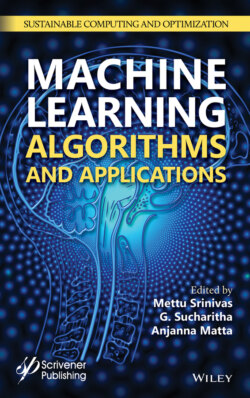Читать книгу Machine Learning Algorithms and Applications - Группа авторов - Страница 22
1.3.3 Algorithms
Оглавление1. K-Means Clustering: The K-means algorithm takes a set of input values and, based on parameter k, clusters the values into k clusters. The division of values into k clusters is based on a similarity index in which data values having close similarity index are grouped into one cluster and another set of values is grouped into another cluster [11]. Distance measures like Euclidean, Manhattan, and Minkowski are some of the similarity indices that are used for clustering. We have used clustering because our dataset values were to be divided into classes. We choose six classes, viz., Good, Satisfactory, Moderately Polluted, Poor, Very Poor, and Severe.
2. Support Vector Machine Algorithm (SVMA) for Prediction: SVMAs are an age old excellent algorithms in use for solving classification and regression problems. SVM provides a supervised learning model and is used to analyze the patterns in the data. In SVM, a linear model is applied to convert non-linear class boundaries to linear classes. This is done by reducing the high-dimensional feature vector space. Kernel selection is an integral part of SVMs. Different kernels exist and we have used linear and Radial Basis Function (RBF) for our experiments. The outputs have been discussed under results. Two major kinds of SVM considered are therefore linear-based modeling and non-linear based modeling.
3. Recurrent Neural Network LSTM Algorithm (LSTM-RNN): Contemporary Neural Networks such as Feed Forward Neural Networks (FFNNs) are different from Recurrent Neural Networks (RNNs) because they are trained on labeled data and forward feed is used till prediction error gets minimized.
RNNs are different from FFNNs because the output or result received at stage t − 1 impacts the output or result received at stage t. In RNN, there are two input values: first one being the present input value and second one being the recent past value. Both inputs are used to compute the new output.
Figure 1.2 shows the simple form of RNN. For a hidden state (ht) which is non-linear transformation in itself, it can be computed using a combination of linear input value (It) and recent hidden past value (ht − 1). From the figure, it can be observed that the output result is computable using the present dependent hidden state ht. The output Ot holds dependence on probability pt which was computed using a function called softmax. Softmax was only computed in the last layer of RNN-based classification before the final result was received.
Figure 1.2 Basic steps of recurrent neural network.
Since RNN in itself suffers from two gradient problems of vanishing gradients and exploding gradients, therefore there have been two modifications to the basic RNN. Gates have been provided to control the impact of the multiplying factor that is majorly responsible for increase (explosion) in gradient (multiplying factor if larger than one) or decrease (vanishing) in gradient (multiplying factor if less than one). We now have LSTM and Gated Recurrent Unit (GRU). LSTM has been used in our work [12].
Because we were trying to predict future values based on present and past pollution data values that were in time series and had lags, therefore LSTM suited our use case. LSTM learns from the historical data to not only classify but also to process the results and predict the future scores without getting affected by gradient incumbencies.
